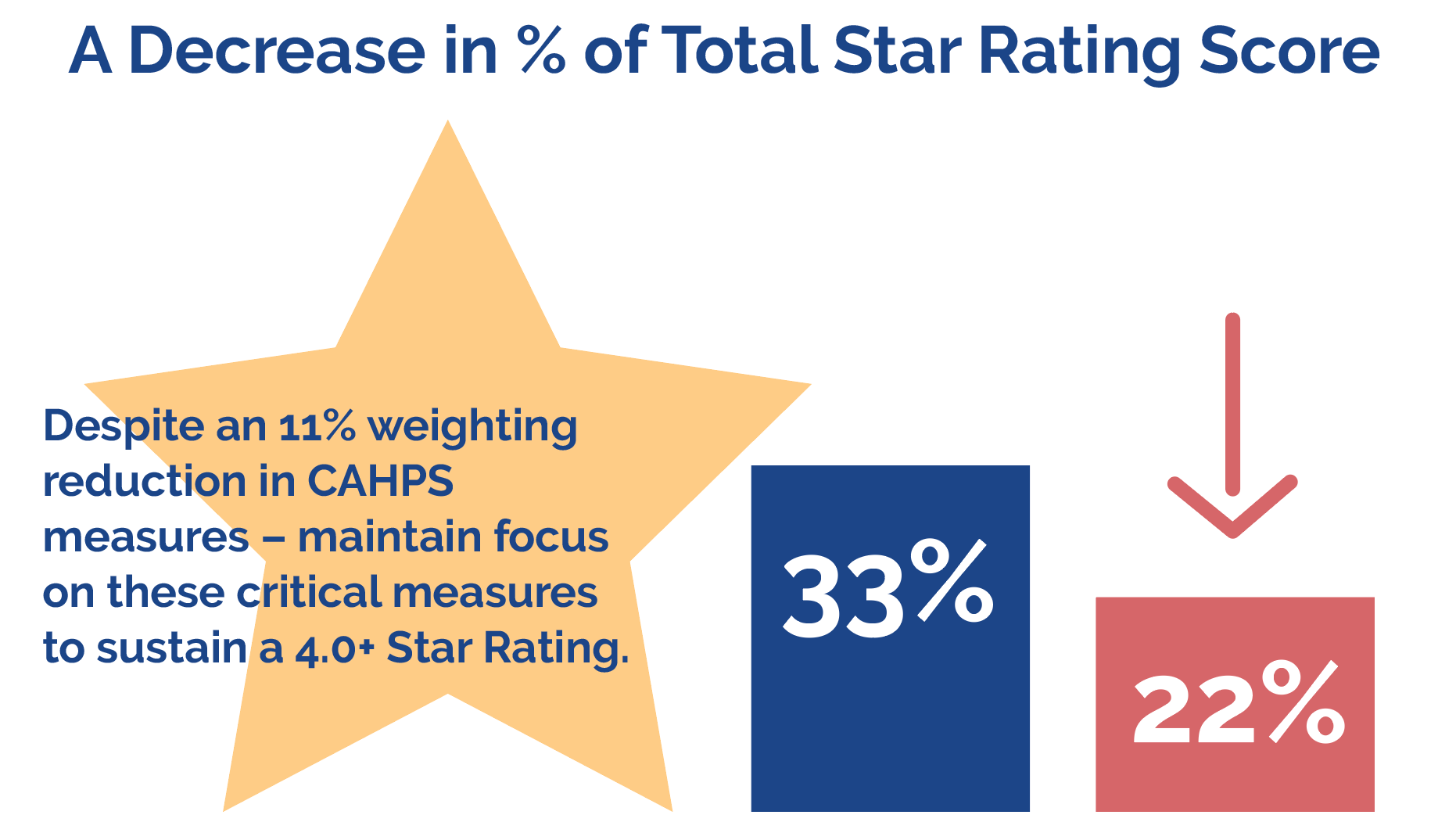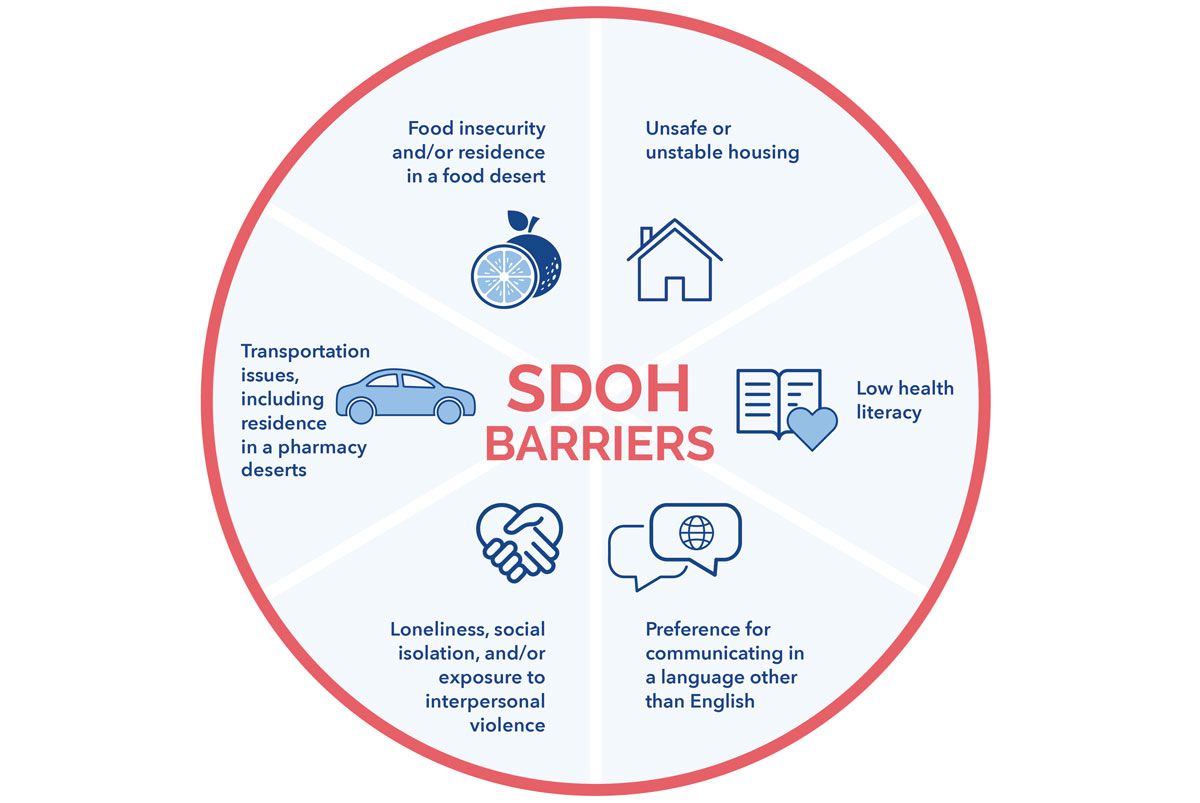News
Article
Contributor: How to Become a Star Ratings “Triple Threat” With CAHPS, Medication Adherence, and an SDOH-First Approach to Member Engagement
Author(s):
Medicare Advantage plans can implement 3 simple steps to make sure that they are competitive in the modern Stars environment.
The complex Star Ratings system is designed to hold Medicare Advantage (MA) plans to the highest standards of clinical care and member experiences. To keep MA plans pushing toward continuous improvement, regulators are constantly tweaking the rubric in response to market trends, performance history, and the industry’s overarching goals.
One of the latest adjustments is a weighting reduction in Consumer Assessment of Healthcare Providers & Systems (CAHPS) measures for the 2026 Star Rating (measurement year 2024) from 4x to 2x, reducing the overall weight of member experience measures from 33% of total Stars scores to 22% of the final rating.
A Decrease in % of Total Star Rating Score | Image Credit: AdhereHealth

While this may seem counterintuitive in the current environment, especially as member experiences take on greater importance with consumers and regulators alike, it’s important for plans to maintain focus on CAHPS scores. One reason being, these measures don’t function in isolation within the Star Ratings system. Instead, CAHPS performance is closely tied to measures that are retaining or increasing their hefty presence, including the triple-weighted medication adherence measures and new approaches to addressing health equity.
Despite the shift in emphasis towards these measures, plans still have pressure to address 3 core competencies that are inextricably linked together: improving medication adherence, reducing socioeconomic barriers to access, and providing optimized experiences.
To achieve “triple threat” status, plans will have to use a combination of advanced technologies and person-first strategies for identifying at-risk members, resolving socioeconomic barriers, and supporting sustained engagement over time.
The intersection between CAHPS, medication adherence and social determinants of health (SDOH)
A good member experience isn’t just about the quality of care a member receives to impact health outcomes. It’s also about how well a health plan assists its members in accessing the care they need for optimal health, especially among people with chronic conditions.
Since 1 of the most effective ways to keep members out of the hospital is to make sure they are taking their medications appropriately, it’s no wonder that medication adherence is viewed as a crucial “force multiplier” for overall Stars performance, and is closely linked to member satisfaction.
At the moment, MA plans could be doing better with both medication adherence and access to care.
Approximately half of all chronic disease patients fail to take their medicines as prescribed, leading to tens of thousands of avoidable deaths and approximately $500 billion in unnecessary spending every year.
A recent study from J.D. Power revealed that only “31% of MA plan members say their plan made it easy for them to find care” but “overall customer satisfaction scores are 158 points higher when members say it’s easy to find care.”
For many members, their challenges with medication adherence and health system access stem from the social determinants of health (SDOH): the constellation of socioeconomic factors that may include food and housing insecurity, social isolation, low health literacy or transportation barriers. These issues can make it difficult to get to a pharmacy, pay for medications, understand and follow care instructions, and communicate effectively with care teams to self-advocate for coordinated, proactive care when necessary.
Social Determinants of Health Barriers | Image credit: AdhereHealth

When plans do not take all these potential barriers into account, members will miss the bar on medication adherence measures and undoubtedly return lower satisfaction scores that could have a negative ripple effect on the plan’s ability to access a substantial portion of the more than $12 billion in the Quality Bonus Payment pool.
3 best practices for triple success within the Star Ratings
An impactful roadmap for Stars success uses a combination of sophisticated predictive analytics and experienced, empathetic outreach clinicians to enhance member experiences and lift plan performance:
1. Adopt a flexible, data-rich technology platform to identify at-risk members
The ability to identify at-risk members is the first step toward addressing their needs. MA plans must adopt digital tools that ingest a variety of data sources, including clinical data, claims data, prescription data and SDOH datasets (such as the CDC social vulnerability index) to flag members at elevated risk of nonadherence and prioritize these members for outreach.
The most effective platforms should include high-value data visualizations, customizable dashboards, intelligent clinical workflows and features that recommend the “next best action” for clinician outreach, while updating on a daily and weekly basis for near–real time interventions that reach members at critical points in their healthcare journeys.
2. Build trusted relationships with members through personalized outreach
Members experiencing SDOH barriers may be reluctant to share their challenges with strangers over the phone, especially if they have had poor interactions with their health plan in the past. Overcoming this hesitancy requires plans to employ or partner with clinical staff well-versed in person-centered strategies, such as motivational interviewing.
When supported by a robust data analytics platform, these engagement specialists can encourage open communication and even check off multiple high-value activities and Stars requirements during each interaction, such as conducting a social needs screening (related to the new SNS-E HEDIS measure) or making an appointment for an Annual Wellness Visit (AWV).
Members are more likely to respond positively to interactions that actively address their self-identified needs, which may translate to fewer barriers to medication adherence and higher CAHPS scores, as well as greater intrinsic motivation and capacity to remain engaged in their ongoing care.
3. Establish long-term follow-up processes that keep members on the path to better health
Leveraging a technology platform that can track completed interventions and continually monitor data to proactively surface changes in risk scores can support timely clinician outreach when a member experiences a change in their clinical or socioeconomic circumstances. Ensuring outreach staff have intuitive access to information on past interactions directly within the workflow is crucial for maintaining strong, seamless relationships with members.
Using advanced analytics to reconnect quickly with members is essential for avoiding days lost to nonadherence, and reinforcing the plan’s position as a caring and supportive member of a personalized care team, once again tapping into the dual relationship between adherence and CAHPS.
Even though the weighting of the CAHPS measures has been reduced, MA plans must keep focus on these measures to stay competitive in the modern Stars environment. Leveraging robust technology and an informed, compassionate human touch will enable plans to take a 3-pronged approach to high performance, all while elevating the member experience and forging stronger, long-term engagements with members to overcome socioeconomic barriers to care.





